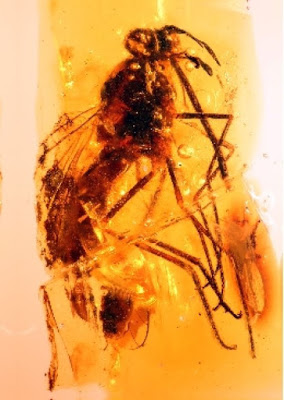
When we think about pollination, the image that comes first to our mind is a bee or a butterfly covered by pollen. However, in the Cretaceous — about 105 million years ago — bees and butterflies did not exist, and most terrestrial ecosystems were dominated by non-flowering plants (gymnosperms).
An international research team has recently discovered some amber fly specimens in El Soplao cave (Cantabria, Spain). According to an article published in the scientific journal Current Biology, these specimens fed on nectar and pollinized gymnosperm plants 105 million years ago. Xavier Delclòs, professor in the Department ofStratigraphy, Paleontology and Marine Geosciences and researcher at the Biodiversity Research Institute (IRBio) of the University of Barcelona, is one of the authors of the study. The article is also authored by Enrique Peñalver and Eduardo Barron (Geological and Mining Institute of Spain, IGME); Antonio Arillo (Complutense University of Madrid, UCM); David Grimaldi (American Museum of Natural History); Ricardo Pérez de la Fuente (Harvard University, USA,) and Mark L. Riccioi (Cornell (University, USA).
Plants and insects: a long history
Plants attract insects with different strategies — for example, with their sweet and nutritious nectar — in order to get them transport pollen and enable the process of pollination. By this way, plants and insects establish a fundamental symbiotic relationship that plays a key role in the preservation of terrestrial ecosystems. Besides bees and other similar species, the most important pollinators in current ecosystems — where flowering plants predominate — are proboscid butterflies, beetles, thrips and flies. On the contrary, in Cretaceous landscapes, dominant species were gymnosperms (for examples, pines, firs, cycads) and the main agent of pollination was the wind.
Flies that pollinated Cretaceous plants
Amber from El Soplao (Cantabria) is providing traces of new insect species key to understand how was life in Cretaceous forests, when today’s Iberian Peninsula was a giant island. The study describes two species of flies, well preserved in amber, which present a long specialized proboscis and belong to the family Zhangsolvidae, extinct before dinosaurs. One of the specimens has hundreds of grains from a Bennettitalean species, an extinct order of gymnosperms.
The study proves that the internal structure of flies’ proboscis has been preserved at a microscopic level, according to evidence provided by computed tomography and transmission electron microscopy. The scientific team has showed that these flies took nectar from plants by approaching them in beating flight, like hummingbirds do.
When angiosperms began to dominate terrestrial ecosystems
There are few known cases of insects that fossilized when they were transporting pollen from one flower to another. The new fossils found in Cantabria show that flies and Bennettitales held a close partnership 105 million years ago. Why amber insects carrying angiosperm pollen have not been found? According to experts, this is an outstanding scientific finding because at that moment angiosperms were beginning to dominate terrestrial ecosystems and diversify in many species.
“If insects were able to feed on gymnosperms flower structures, it is probably true that the transition to angiosperms took place then,” affirm the authors of the study.
Video
Reference:
Enrique Peñalver, Antonio Arillo, Ricardo Pérez-de la Fuente, Mark L. Riccio, Xavier Delclòs, Eduardo Barrón, David A. Grimaldi. Long-Proboscid Flies as Pollinators of Cretaceous Gymnosperms. Current Biology, 2015; DOI: 10.1016/j.cub.2015.05.062
Note: The above post is reprinted from materials provided by Universidad de Barcelona.










